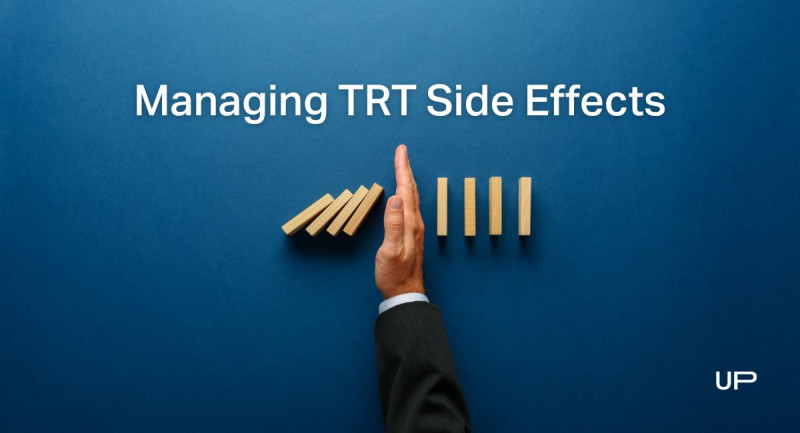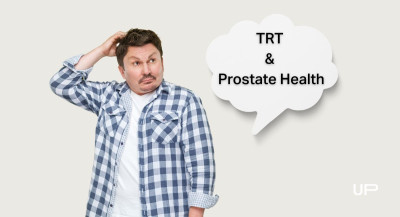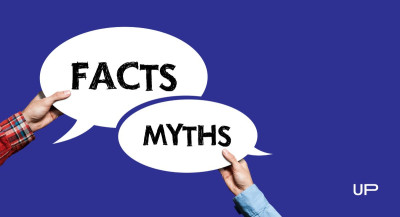Managing TRT Side Effects: Acne, Breast Growth & Blood Thickening


When starting testosterone replacement therapy (TRT) in Canada, most men are well-informed about the common concerns—like hair loss, infertility, or mood swings.

But fewer are prepared for the less-discussed side effects that can affect comfort, confidence, and long-term health. From TRT-related acne and unexpected breast tissue growth (gynecomastia) to elevated hematocrit levels (which can thicken the blood and raise cardiovascular risks), these issues often take men by surprise.
They’re not rare, they’re not always dangerous, but they do require awareness and proper medical monitoring. In this article, we break down how these side effects happen, who’s more likely to experience them, and how to manage them—especially for men receiving testosterone replacement therapy in Canada.
Topics covered in this article:
- Acne & Skin Changes: Causes and Skincare Tips
- Gynecomastia: Understanding Estrogen Imbalance
- High Hematocrit: Why Blood Thickness Matters
- Managing TRT Side Effects Medically: AIs, Blood Draws, and Dose Adjustments
- Lifestyle Strategies: Diet, Hydration, and Skincare
- Regular Monitoring: When to Test Labs and How Often
- Conclusion: Most TRT Side Effects Are Manageable
- Frequently Asked Questions (FAQs)
- References
Acne & Skin Changes: Causes and Skincare Tips
One of the more surprising side effects of testosterone replacement therapy (TRT) is a return of acne or oily skin, particularly for men who haven’t dealt with breakouts since their teens. This happens because increased testosterone can stimulate sebaceous glands, boosting oil production and leading to clogged pores—especially on the back, chest, and face.

In Canada, dermatologists and hormone specialists often advise a combination of lifestyle and skincare strategies to manage TRT-related acne. Here are a few evidence-backed approaches that can help:
- Use gentle, non-comedogenic cleansers: Harsh soaps can irritate the skin and worsen inflammation. Look for products with salicylic acid or benzoyl peroxide.
- Shower after workouts: Sweat mixed with oil can clog pores, so post-exercise hygiene matters.
- Watch your diet: High glycemic foods and dairy may contribute to acne in some individuals. Try cutting back and observing changes.
- Ask your doctor about dosage or delivery: Sometimes switching from injections to a transdermal gel can reduce skin-related side effects.
If acne becomes persistent or severe, consult your provider. They may recommend topical treatments, oral medications, or even adjusting your TRT protocol to balance hormone levels more effectively.
Gynecomastia: Understanding Estrogen Imbalance
Gynecomastia, the development of excess breast tissue in men, can be an unexpected and emotionally difficult side effect of testosterone replacement therapy (TRT). While it’s not extremely common, it does occur in some men when testosterone converts to estrogen via a process called aromatization. Elevated estrogen can stimulate breast tissue growth, especially if not properly monitored.
In Canada, most TRT clinics and endocrinologists closely track estrogen levels alongside testosterone to catch imbalances early. Men on TRT should be aware of these warning signs:
- Tenderness or swelling in the chest
- Puffiness under the nipples
- Visible changes in chest shape
Fortunately, gynecomastia linked to TRT is often preventable and reversible when caught early. Medical strategies may include:
- Adjusting testosterone dosage
- Adding an aromatase inhibitor (a medication that reduces estrogen production)
- Switching delivery methods (e.g., gel instead of injection, if peaks and troughs are causing hormonal spikes)
If breast tissue growth becomes more pronounced, your healthcare provider may refer you to a specialist. The key takeaway: with regular monitoring and open communication, gynecomastia is manageable—not a dealbreaker for staying on TRT.
High Hematocrit: Why Blood Thickness Matters
One lesser-known but important side effect of testosterone replacement therapy (TRT) in Canada is an increase in hematocrit—the percentage of red blood cells in your blood. While TRT can stimulate red blood cell production (a normal part of its anabolic effect), elevated hematocrit levels can thicken the blood and raise the risk of complications like high blood pressure, headaches, or in rare cases, blood clots.
This side effect doesn't happen to everyone, but it’s common enough that most Canadian TRT clinics include hematocrit checks in their routine bloodwork.
Here’s what men on TRT should know:
- Normal hematocrit ranges are usually 38–50%. Anything above 54% may be a red flag.
- Symptoms of high hematocrit may include flushed skin, fatigue, dizziness, or shortness of breath.
- Simple lifestyle steps—like staying hydrated, avoiding smoking, and donating blood periodically—can help lower hematocrit naturally.
If levels remain elevated, your healthcare provider may adjust your dosage, change the delivery method, or recommend therapeutic phlebotomy (a medically supervised blood draw) to bring levels down safely.
Monitoring hematocrit is one of the easiest ways to keep TRT both safe and sustainable over the long term. It’s not a reason to avoid therapy—it’s a reminder that responsible care matters.

Managing TRT Side Effects Medically: AIs, Blood Draws, and Dose Adjustments
When testosterone replacement therapy (TRT) leads to uncomfortable or risky side effects, medical interventions can help keep things in check. In Canada, testosterone therapy is closely monitored by healthcare providers to ensure safe, long-term outcomes. If estrogen levels rise too high—sometimes leading to gynecomastia (male breast tissue growth) or mood swings—aromatase inhibitors (AIs) may be prescribed. These medications reduce the conversion of testosterone into estrogen and can help restore hormonal balance.
Another common concern is elevated hematocrit, which makes the blood thicker and increases the risk of high blood pressure or clotting. In such cases, your doctor might recommend therapeutic blood draws (also known as phlebotomy) to bring levels back to normal.
Finally, adjusting your TRT dose is often the simplest and most effective way to manage side effects. If your symptoms are linked to too much testosterone or too rapid a rise in levels, a slightly lower or more spaced-out dose can resolve issues without stopping treatment altogether.
These medical strategies, guided by regular lab work and doctor consultations, help men stay on TRT safely while avoiding unwanted complications.
Lifestyle Strategies: Diet, Hydration, and Skincare
Managing the lesser-known side effects of testosterone replacement therapy (TRT) in Canada doesn’t always require medication. Simple lifestyle adjustments can go a long way—especially when it comes to skin health, hormone regulation, and overall wellness.
- Prioritize anti-inflammatory foods like leafy greens, berries, fatty fish, and whole grains to help balance oil production and reduce acne flare-ups.
- Stay well-hydrated to support your liver and kidneys in processing hormones efficiently and keeping your skin clear.
- Limit processed sugar and dairy, which may worsen breakouts in some men by triggering hormonal spikes.
- Stick to a gentle skincare routine using non-comedogenic products, fragrance-free cleansers, and lightweight moisturizers to avoid clogging pores irritated by TRT-related oil changes.
- Avoid harsh exfoliants and over-washing, which can strip the skin and trigger more oil production.
These strategies won’t eliminate side effects alone, but when combined with medical oversight, they support hormonal balance and reduce the likelihood of skin and systemic issues over time.

Regular Monitoring: When to Test Labs and How Often
For men undergoing testosterone replacement therapy (TRT) in Canada, consistent lab monitoring is critical to staying safe and getting the most out of treatment. Side effects like elevated hematocrit, increased estrogen, or changes in liver enzymes often show up in bloodwork before symptoms appear—so testing isn’t optional, it’s essential.
Here’s what to monitor and when:
- Testosterone levels: Every 3 to 6 months, to ensure your dose is effective and in range.
- Estradiol (E2): Every 6 to 12 months, especially if symptoms of high estrogen like gynecomastia or mood swings occur.
- Hematocrit and hemoglobin: Every 3 to 6 months in the first year, then annually if stable. High levels can increase clot risk.
- Prostate-specific antigen (PSA): Annually, especially for men over 50, or those with prostate concerns.
- Liver function tests: Periodically, to monitor for any rare medication effects.
- Lipid panel: Annually, since TRT can impact cholesterol levels.
Work with a qualified provider in Canada to interpret your results and adjust treatment if needed. Skipping lab work may delay identifying preventable risks, and limit your long-term success on TRT.

Conclusion: Most TRT Side Effects Are Manageable
Testosterone replacement therapy (TRT) in Canada can be life-changing, but it’s not without its challenges. Side effects like acne, gynecomastia, or elevated hematocrit may sound alarming—but with proper medical guidance, routine lab monitoring, and thoughtful lifestyle habits, most of these issues can be prevented or effectively managed.
The key takeaway: TRT doesn’t have to mean trading one problem for another. With a knowledgeable healthcare provider and a commitment to regular check-ins, men can safely navigate these side effects and continue reaping the benefits of restored testosterone—more energy, better mood, improved strength, and enhanced quality of life.
Testosterone therapy is a journey, not a one-time fix. But for many men in Canada, it’s a journey worth taking—with clarity, caution, and the right support.
Frequently Asked Questions (FAQs)
Yes, acne is a relatively common side effect of TRT, especially in the early stages of treatment. Elevated androgen levels can stimulate oil glands, leading to breakouts. This is usually manageable with proper skin care, hydration, and, in some cases, adjusting dosage or delivery method.
In some cases, TRT can lead to increased estrogen levels, which may contribute to gynecomastia. This side effect can often be prevented or treated with medical interventions like aromatase inhibitors or by adjusting the TRT protocol under medical supervision.
Polycythemia is a condition where the body produces too many red blood cells, thickening the blood. TRT can raise hematocrit levels, increasing this risk. Regular blood work is essential to monitor hematocrit, and in some cases, therapeutic phlebotomy may be recommended.
Most physicians recommend blood tests every 3–6 months during the first year of TRT, and then annually if levels stabilize. Tests often include total and free testosterone, hematocrit, PSA, and estradiol levels, depending on individual needs.
Absolutely. Staying hydrated, eating a nutrient-rich diet, avoiding alcohol and processed foods, using non-comedogenic skincare products, and getting regular exercise can all help reduce the likelihood and severity of TRT-related side effects.
References
UPGUYS has strict sourcing guidelines to ensure our content is accurate and current. We rely on peer-reviewed studies, academic research institutions, and medical associations. We strive to use primary sources and refrain from using tertiary references.- Risks of testosterone replacement therapy in men, PubMed,
https://pmc.ncbi.nlm.nih.gov/articles/PMC3897047/ - Management of Adverse Effects in Testosterone Replacement Therapy, PubMed,
https://pubmed.ncbi.nlm.nih.gov/39908204/ - Effects of Diet on Acne and Its Response to Treatment, PubMed,
https://pmc.ncbi.nlm.nih.gov/articles/PMC7847434/?utm_source=chatgpt.com - Testosterone use causing erythrocytosis, PubMed,
https://pmc.ncbi.nlm.nih.gov/articles/PMC5647167/
This article is written for informational purposes only and does not constitute medical advice. The information provided in the articles cannot and should not replace advice from a healthcare professional. Talk to your healthcare provider about any physical or mental health concerns or the risks and benefits of any treatment or medication.





